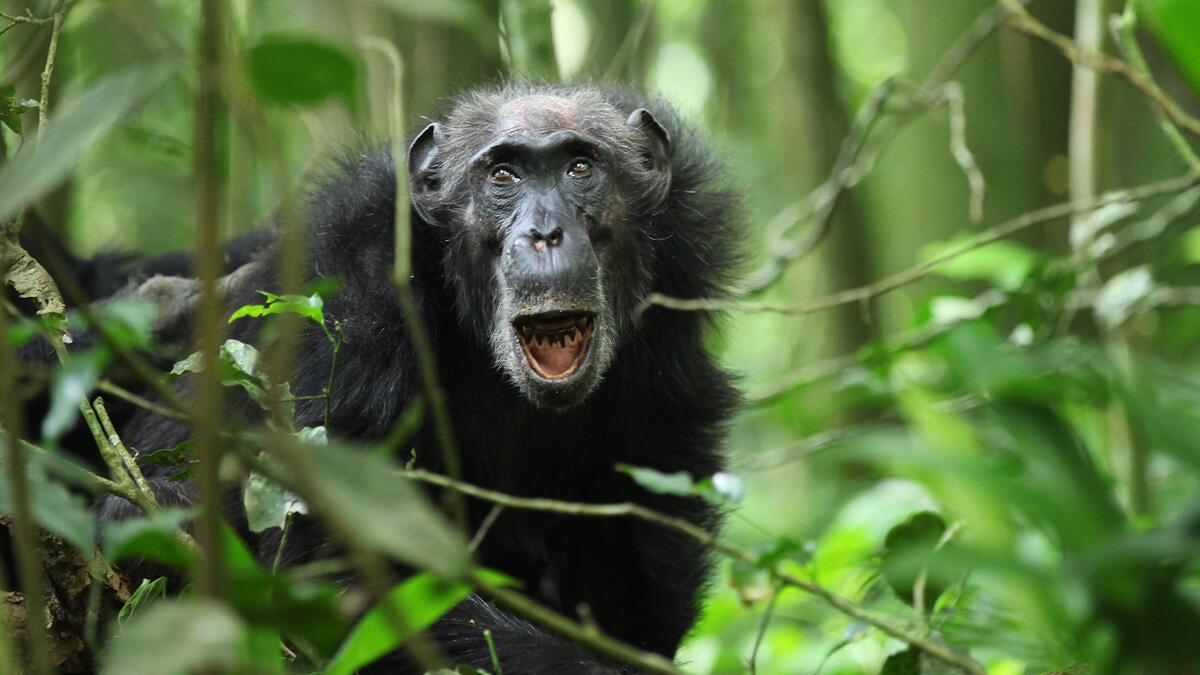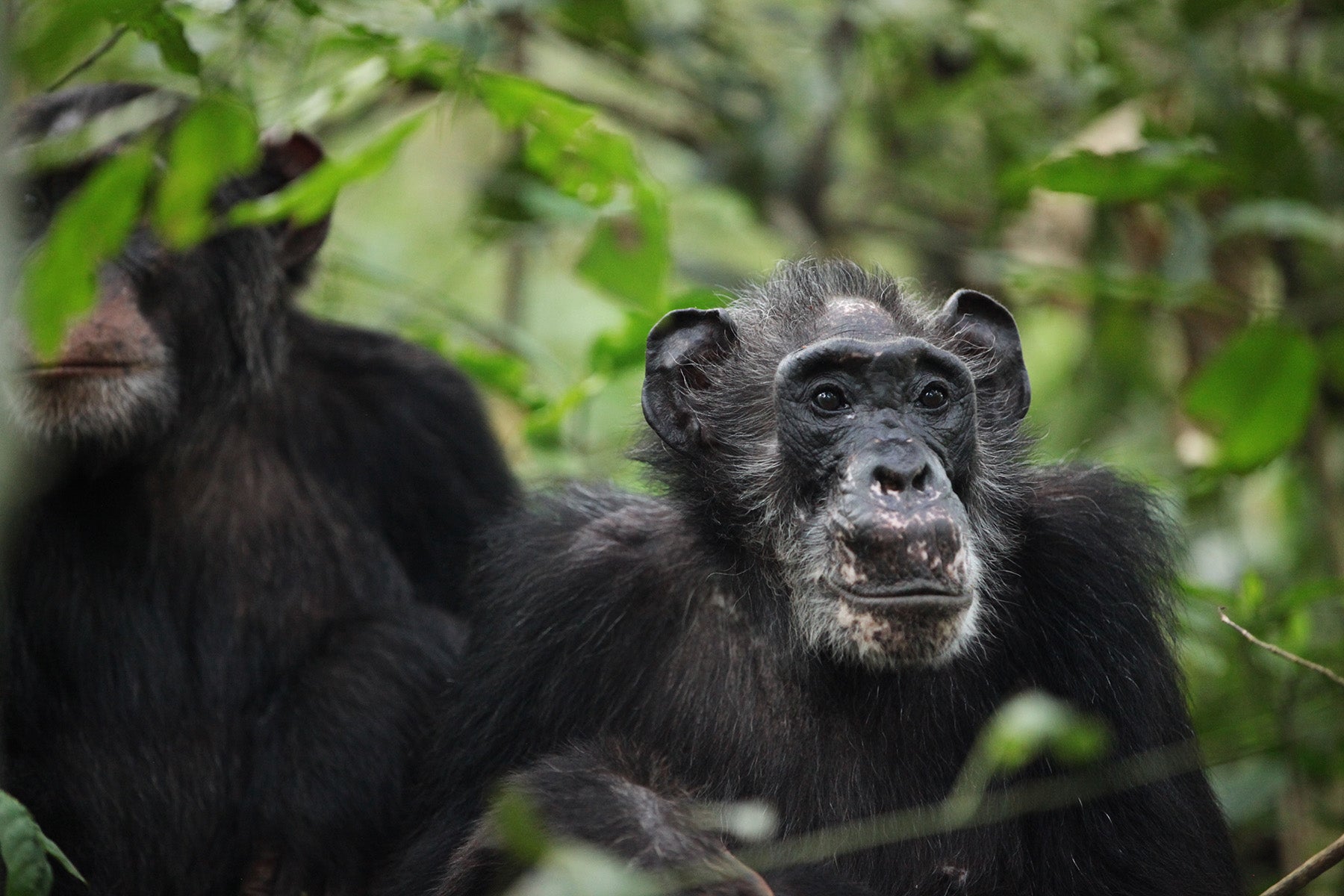Post-reproductive benefits unclear for chimpanzee 'grandmothers'

Ngogo chimpanzee Marlene. Photo courtesy Kevin Langergraber
In most animals living in nature, females continue to reproduce until they die. However, in some species, including humans and a few species of toothed whales, females continue to live for many years after they can no longer reproduce.
Substantial post-reproductive lifespans, where women spend about 40% of their adult years in a post-reproductive state, are a universal human trait. They are observed in traditional hunter-gatherer societies, suggesting that they are not an artifact of recent advances in medical care and public health. Rather, they are a trait that has evolved in our species.
The evolution of post-reproductive lifespans is puzzling from an evolutionary perspective. Natural selection favors the evolution of traits that help individuals pass on more of their genes. So how then could natural selection favor the persistence of lifespan past the point at which the individual can reproduce? The most prominent answer to this question is the “grandmother hypothesis.”
New research published this week in the journal Science by ASU primatologist Kevin Langergraber and a team of international collaborators, however, questions the necessity of the grandmother hypothesis for the evolution of post-reproductive lifespans.
In many human societies, including those living a hunter-gather lifestyle, grandmothers play an important role in the lives of their descendants in the form of babysitting, food sharing and the transfer of important knowledge. A large body of evidence from a diverse range of societies shows that individuals who have a grandmother living in their group have higher survival than individuals who do not. The grandmother hypothesis states that it pays an older female more, in terms of number of genes that get into subsequent generations, to help offspring reproduce (thus producing more grandchildren) and grandoffspring survive than it does for them to continue reproducing themselves.
Data from our close primate relatives are especially valuable for the reconstruction and causal modeling of human life history evolution. Using over 20 years of demographic data from the Ngogo community of chimpanzees in Kibale National Park, Uganda, researchers found that the average female there spends about 20% of her adult years in a post-reproductive state. They also analyzed urine samples to show that post-reproductive female chimpanzees undergo similar hormonal changes as human women, including increased levels of gonadotropin hormones (FSH: follicular stimulating hormone and LH: luteinizing hormone) and decreased levels of ovarian hormones (e.g., estrogen).
As in humans, female chimpanzee fertility gradually decreased through the 30s and ended at about age 50. These results suggest that the timing and physiological cause of reproduction (i.e., menopause, the depletion of the lifetime supply of ovarian follicles) are similar in humans and their closest living relatives.
Although the occasional older post-reproductive female has been observed in other chimpanzee communities, these new results are the first showing a substantial post-reproductive lifespan for this species. Why this contrast?

Ngogo chimpanzees Ma Rainey (right) and Wes. Photo courtesy Kevin Langergraber
“Chimpanzees elsewhere rarely live past age 50. What is really different at Ngogo is that we have high survival, for both sexes, into older ages,” said Langergraber, an associate professor in the School of Human Evolution and Social Change and a research scientist with the Institute of Human Origins who has been studying the Ngogo community of chimpanzees for over 20 years.
“This raises questions about the reasons and significance of these differences of later age survival. Are conditions at Ngogo unusually good compared to those experienced throughout evolutionary history? Maybe post-reproductive lifespans we see at Ngogo are a temporary artefact, without much evolutionary significance. We know that lots of species have post-reproductive lifespans in the protective conditions of captivity, where they are fed and receive medical care.”
But another possibility the authors raise is that the conditions and survival patterns observed at Ngogo are more representative of the species and that a substantial post-reproductive lifespan has not been observed in other chimpanzee populations because of the recent negative impacts of humans.
“Chimpanzees are extremely susceptible to diseases that originate in humans and to which they have no natural immunity. We did not know this in the earlier days of chimpanzee research, and many chimps died from the very researchers who were trying to study and protect them,” Langergraber said.
“Years before the COVID-19 pandemic, chimpanzee researchers were wearing masks, maintaining a 7-meter ‘social distance’ from their chimpanzee subjects, and sanitizing their hands to reduce the chances of human-to-chimp disease transmission,” Langergraber said. “We will need many years of responsible research at multiple chimpanzee populations to settle the question of whether substantial post-reproductive lifespans are an occasional phenomenon or are actually a widespread, species-typical trait.”
Already, however, the presence of substantial post-reproductive lifespans does raise some questions about the grandmother hypotheses. Unlike humans, chimpanzees do little to help their grandoffspring survive or reproduce. Because males stay in the group in which they were born while females leave to reproduce in another group, mothers usually live in different groups than their daughters and their daughters’ offspring.
While mothers do live alongside their sons in the same group and maintain lifelong social bonds with them, previous research by Langergraber and colleagues shows that the mother’s presence is not associated with higher fertility in their sons. And since chimpanzee females mate with so many males for each conception, it is doubtful that grandmothers could increase the fitness of their sons’ offspring, as it would be difficult to identify them.
“We have a lot of work to do to fully understand how this unusual trait of a long post-reproductive life evolved,” Langergraber said. “Step one will be documenting in which species it occurs in nature and carefully considering whether absences are ‘true absences’ or are the result of the recent negative impacts of humans.”
Article: "Demographic and hormonal evidence for menopause in wild chimpanzees." Brian M. Wood, Jacob D. Negrey, Janine L. Brown, Tobias Deschner, Melissa Emery Thompson, Sholly Gunter, John C. Mitani, David P. Watts, Kevin E. Langergraber. Science. doi: 10.1126/science.add5473.
More Science and technology

The Polytechnic School at ASU hits milestone mark at 10 years
The year was 2014.Taylor Swift released “1989.” "Frozen” and its soundtrack were stuck in the minds of many.Facebook was…

Study finds cerebellum plays role in cognition — and it's different for males and females
Research has shown there can be sex differences between how male and female brains are wired.For example, links have been made…

Artificial intelligence drives need for real data storage innovations
In southeastern Mesa, Arizona, construction crews are hard at work on a state-of-the-art data center. The $1 billion…